Role of SMSF in Australia
VerifiedAdded on 2023/01/11
|16
|3237
|41
AI Summary
This research report explores the structure, management, and regulation of SMSF in Australia and analyzes the data on investment and diversification in SMSF funds. It provides recommendations based on the data analysis.
Contribute Materials
Your contribution can guide someone’s learning journey. Share your
documents today.
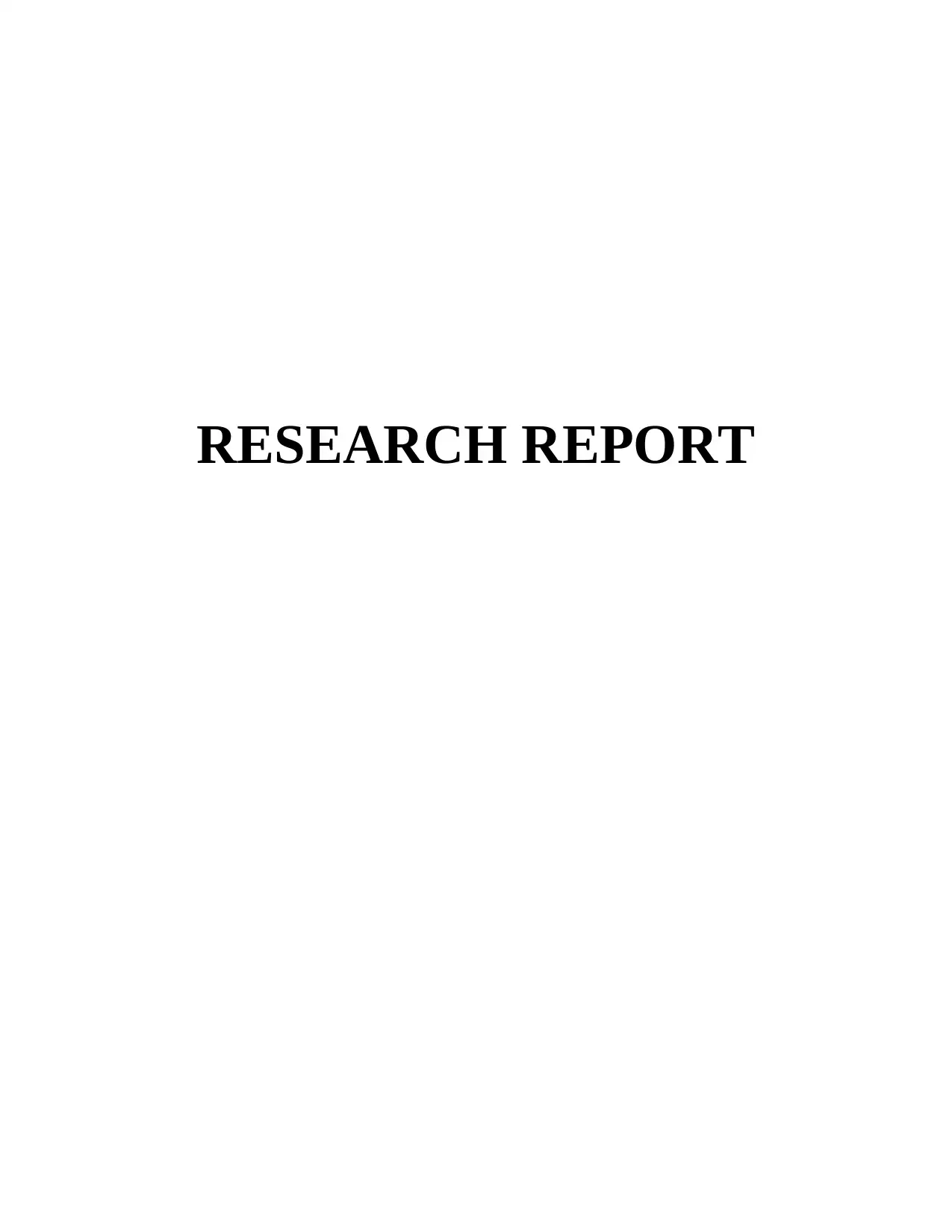
RESEARCH REPORT
Secure Best Marks with AI Grader
Need help grading? Try our AI Grader for instant feedback on your assignments.
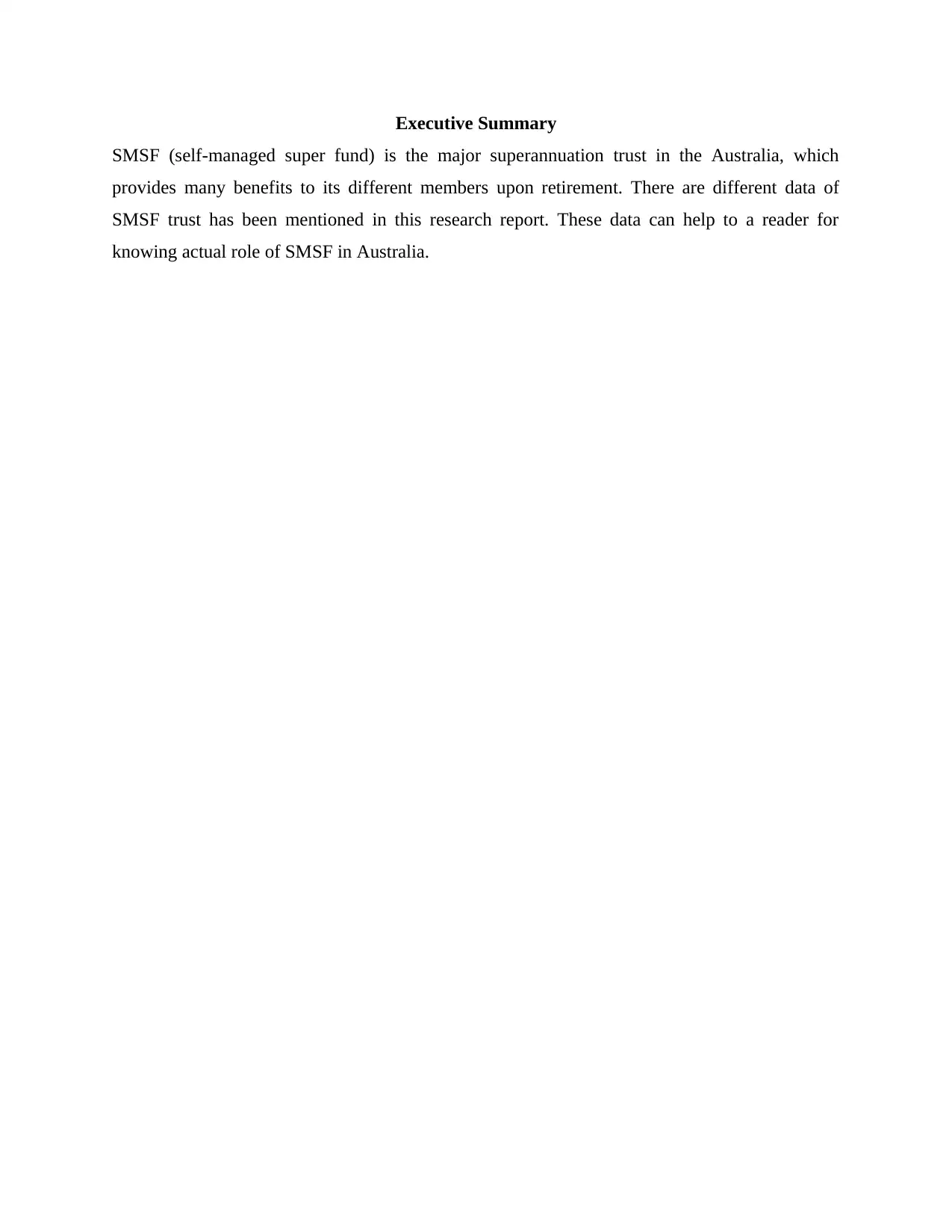
Executive Summary
SMSF (self-managed super fund) is the major superannuation trust in the Australia, which
provides many benefits to its different members upon retirement. There are different data of
SMSF trust has been mentioned in this research report. These data can help to a reader for
knowing actual role of SMSF in Australia.
SMSF (self-managed super fund) is the major superannuation trust in the Australia, which
provides many benefits to its different members upon retirement. There are different data of
SMSF trust has been mentioned in this research report. These data can help to a reader for
knowing actual role of SMSF in Australia.
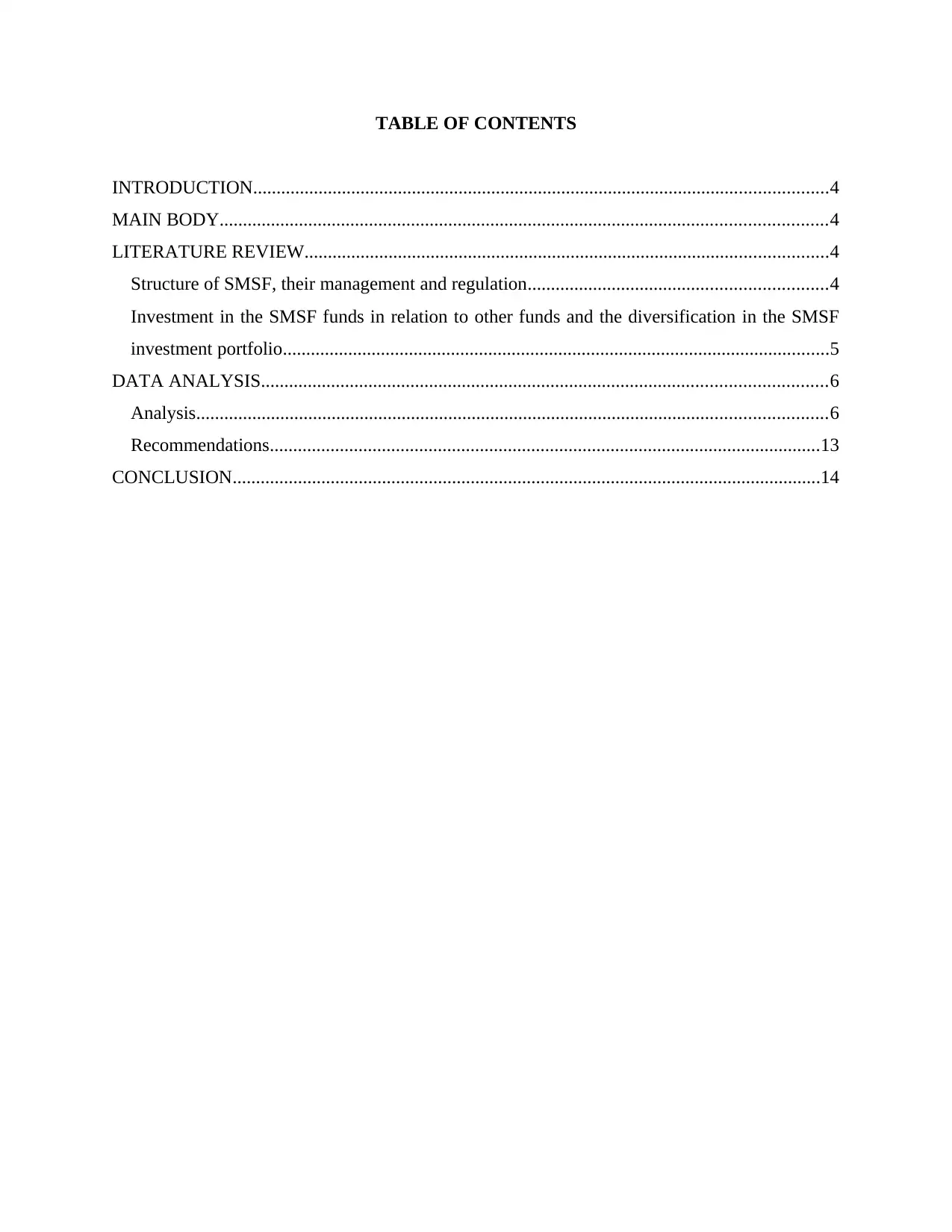
TABLE OF CONTENTS
INTRODUCTION...........................................................................................................................4
MAIN BODY..................................................................................................................................4
LITERATURE REVIEW................................................................................................................4
Structure of SMSF, their management and regulation................................................................4
Investment in the SMSF funds in relation to other funds and the diversification in the SMSF
investment portfolio.....................................................................................................................5
DATA ANALYSIS.........................................................................................................................6
Analysis.......................................................................................................................................6
Recommendations......................................................................................................................13
CONCLUSION..............................................................................................................................14
INTRODUCTION...........................................................................................................................4
MAIN BODY..................................................................................................................................4
LITERATURE REVIEW................................................................................................................4
Structure of SMSF, their management and regulation................................................................4
Investment in the SMSF funds in relation to other funds and the diversification in the SMSF
investment portfolio.....................................................................................................................5
DATA ANALYSIS.........................................................................................................................6
Analysis.......................................................................................................................................6
Recommendations......................................................................................................................13
CONCLUSION..............................................................................................................................14
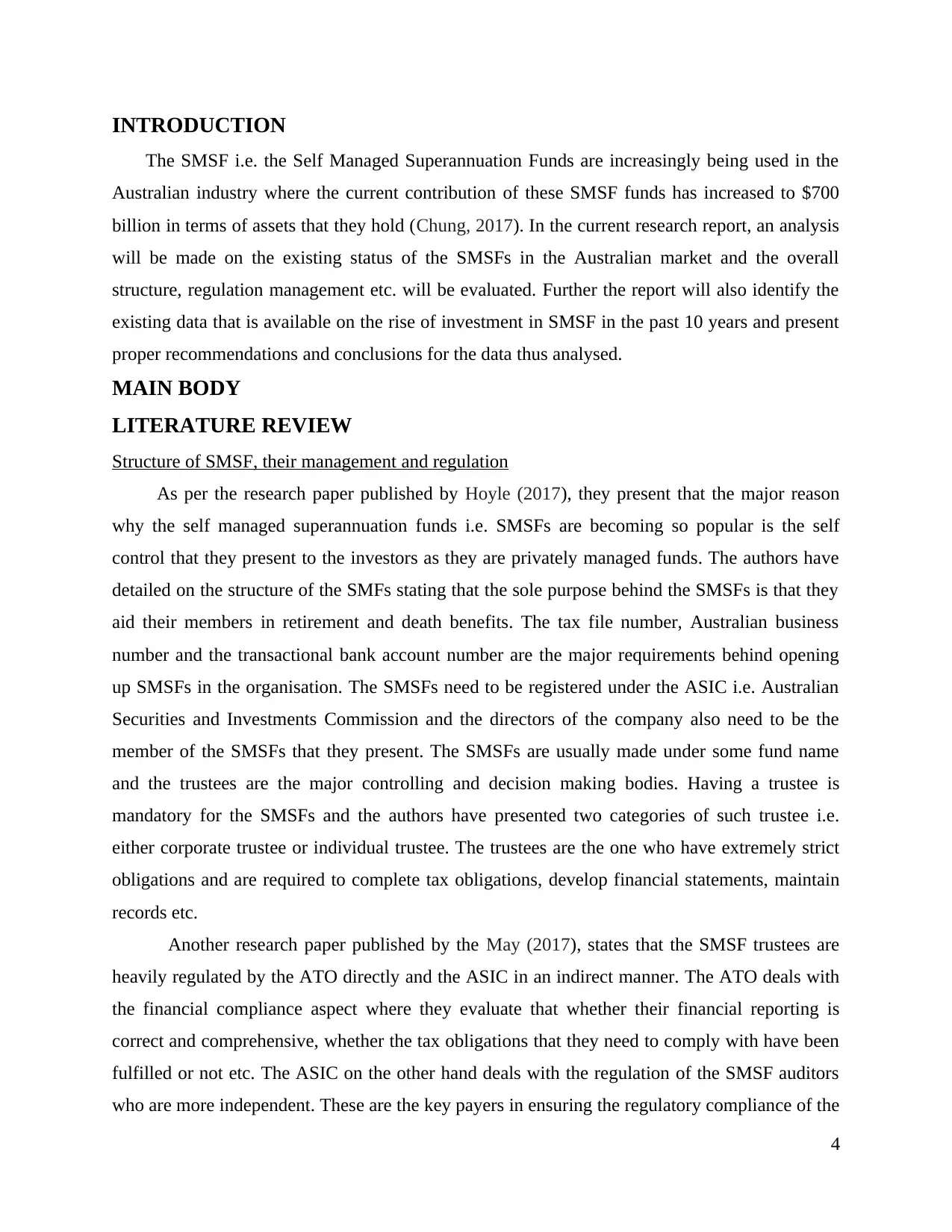
INTRODUCTION
The SMSF i.e. the Self Managed Superannuation Funds are increasingly being used in the
Australian industry where the current contribution of these SMSF funds has increased to $700
billion in terms of assets that they hold (Chung, 2017). In the current research report, an analysis
will be made on the existing status of the SMSFs in the Australian market and the overall
structure, regulation management etc. will be evaluated. Further the report will also identify the
existing data that is available on the rise of investment in SMSF in the past 10 years and present
proper recommendations and conclusions for the data thus analysed.
MAIN BODY
LITERATURE REVIEW
Structure of SMSF, their management and regulation
As per the research paper published by Hoyle (2017), they present that the major reason
why the self managed superannuation funds i.e. SMSFs are becoming so popular is the self
control that they present to the investors as they are privately managed funds. The authors have
detailed on the structure of the SMFs stating that the sole purpose behind the SMSFs is that they
aid their members in retirement and death benefits. The tax file number, Australian business
number and the transactional bank account number are the major requirements behind opening
up SMSFs in the organisation. The SMSFs need to be registered under the ASIC i.e. Australian
Securities and Investments Commission and the directors of the company also need to be the
member of the SMSFs that they present. The SMSFs are usually made under some fund name
and the trustees are the major controlling and decision making bodies. Having a trustee is
mandatory for the SMSFs and the authors have presented two categories of such trustee i.e.
either corporate trustee or individual trustee. The trustees are the one who have extremely strict
obligations and are required to complete tax obligations, develop financial statements, maintain
records etc.
Another research paper published by the May (2017), states that the SMSF trustees are
heavily regulated by the ATO directly and the ASIC in an indirect manner. The ATO deals with
the financial compliance aspect where they evaluate that whether their financial reporting is
correct and comprehensive, whether the tax obligations that they need to comply with have been
fulfilled or not etc. The ASIC on the other hand deals with the regulation of the SMSF auditors
who are more independent. These are the key payers in ensuring the regulatory compliance of the
4
The SMSF i.e. the Self Managed Superannuation Funds are increasingly being used in the
Australian industry where the current contribution of these SMSF funds has increased to $700
billion in terms of assets that they hold (Chung, 2017). In the current research report, an analysis
will be made on the existing status of the SMSFs in the Australian market and the overall
structure, regulation management etc. will be evaluated. Further the report will also identify the
existing data that is available on the rise of investment in SMSF in the past 10 years and present
proper recommendations and conclusions for the data thus analysed.
MAIN BODY
LITERATURE REVIEW
Structure of SMSF, their management and regulation
As per the research paper published by Hoyle (2017), they present that the major reason
why the self managed superannuation funds i.e. SMSFs are becoming so popular is the self
control that they present to the investors as they are privately managed funds. The authors have
detailed on the structure of the SMFs stating that the sole purpose behind the SMSFs is that they
aid their members in retirement and death benefits. The tax file number, Australian business
number and the transactional bank account number are the major requirements behind opening
up SMSFs in the organisation. The SMSFs need to be registered under the ASIC i.e. Australian
Securities and Investments Commission and the directors of the company also need to be the
member of the SMSFs that they present. The SMSFs are usually made under some fund name
and the trustees are the major controlling and decision making bodies. Having a trustee is
mandatory for the SMSFs and the authors have presented two categories of such trustee i.e.
either corporate trustee or individual trustee. The trustees are the one who have extremely strict
obligations and are required to complete tax obligations, develop financial statements, maintain
records etc.
Another research paper published by the May (2017), states that the SMSF trustees are
heavily regulated by the ATO directly and the ASIC in an indirect manner. The ATO deals with
the financial compliance aspect where they evaluate that whether their financial reporting is
correct and comprehensive, whether the tax obligations that they need to comply with have been
fulfilled or not etc. The ASIC on the other hand deals with the regulation of the SMSF auditors
who are more independent. These are the key payers in ensuring the regulatory compliance of the
4
Paraphrase This Document
Need a fresh take? Get an instant paraphrase of this document with our AI Paraphraser
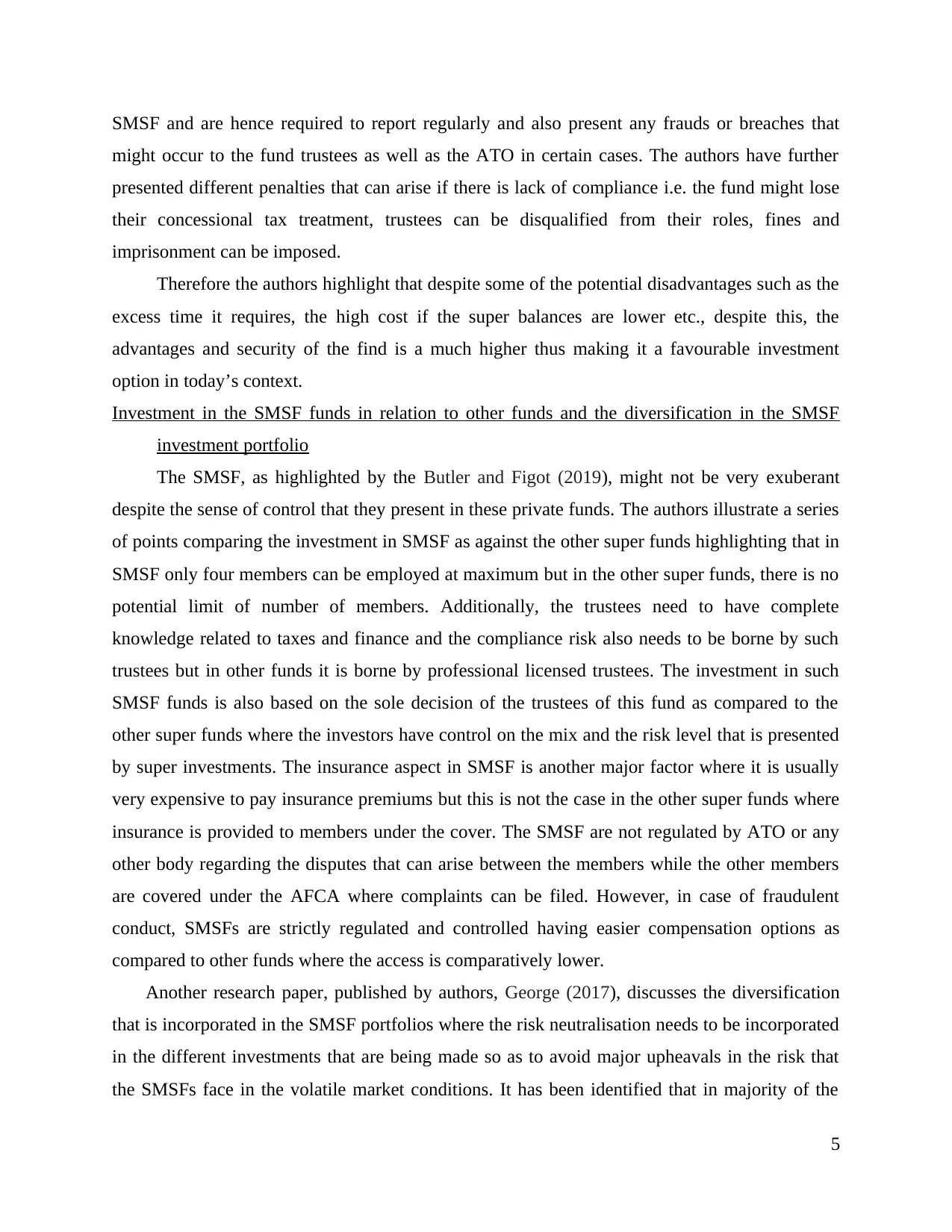
SMSF and are hence required to report regularly and also present any frauds or breaches that
might occur to the fund trustees as well as the ATO in certain cases. The authors have further
presented different penalties that can arise if there is lack of compliance i.e. the fund might lose
their concessional tax treatment, trustees can be disqualified from their roles, fines and
imprisonment can be imposed.
Therefore the authors highlight that despite some of the potential disadvantages such as the
excess time it requires, the high cost if the super balances are lower etc., despite this, the
advantages and security of the find is a much higher thus making it a favourable investment
option in today’s context.
Investment in the SMSF funds in relation to other funds and the diversification in the SMSF
investment portfolio
The SMSF, as highlighted by the Butler and Figot (2019), might not be very exuberant
despite the sense of control that they present in these private funds. The authors illustrate a series
of points comparing the investment in SMSF as against the other super funds highlighting that in
SMSF only four members can be employed at maximum but in the other super funds, there is no
potential limit of number of members. Additionally, the trustees need to have complete
knowledge related to taxes and finance and the compliance risk also needs to be borne by such
trustees but in other funds it is borne by professional licensed trustees. The investment in such
SMSF funds is also based on the sole decision of the trustees of this fund as compared to the
other super funds where the investors have control on the mix and the risk level that is presented
by super investments. The insurance aspect in SMSF is another major factor where it is usually
very expensive to pay insurance premiums but this is not the case in the other super funds where
insurance is provided to members under the cover. The SMSF are not regulated by ATO or any
other body regarding the disputes that can arise between the members while the other members
are covered under the AFCA where complaints can be filed. However, in case of fraudulent
conduct, SMSFs are strictly regulated and controlled having easier compensation options as
compared to other funds where the access is comparatively lower.
Another research paper, published by authors, George (2017), discusses the diversification
that is incorporated in the SMSF portfolios where the risk neutralisation needs to be incorporated
in the different investments that are being made so as to avoid major upheavals in the risk that
the SMSFs face in the volatile market conditions. It has been identified that in majority of the
5
might occur to the fund trustees as well as the ATO in certain cases. The authors have further
presented different penalties that can arise if there is lack of compliance i.e. the fund might lose
their concessional tax treatment, trustees can be disqualified from their roles, fines and
imprisonment can be imposed.
Therefore the authors highlight that despite some of the potential disadvantages such as the
excess time it requires, the high cost if the super balances are lower etc., despite this, the
advantages and security of the find is a much higher thus making it a favourable investment
option in today’s context.
Investment in the SMSF funds in relation to other funds and the diversification in the SMSF
investment portfolio
The SMSF, as highlighted by the Butler and Figot (2019), might not be very exuberant
despite the sense of control that they present in these private funds. The authors illustrate a series
of points comparing the investment in SMSF as against the other super funds highlighting that in
SMSF only four members can be employed at maximum but in the other super funds, there is no
potential limit of number of members. Additionally, the trustees need to have complete
knowledge related to taxes and finance and the compliance risk also needs to be borne by such
trustees but in other funds it is borne by professional licensed trustees. The investment in such
SMSF funds is also based on the sole decision of the trustees of this fund as compared to the
other super funds where the investors have control on the mix and the risk level that is presented
by super investments. The insurance aspect in SMSF is another major factor where it is usually
very expensive to pay insurance premiums but this is not the case in the other super funds where
insurance is provided to members under the cover. The SMSF are not regulated by ATO or any
other body regarding the disputes that can arise between the members while the other members
are covered under the AFCA where complaints can be filed. However, in case of fraudulent
conduct, SMSFs are strictly regulated and controlled having easier compensation options as
compared to other funds where the access is comparatively lower.
Another research paper, published by authors, George (2017), discusses the diversification
that is incorporated in the SMSF portfolios where the risk neutralisation needs to be incorporated
in the different investments that are being made so as to avoid major upheavals in the risk that
the SMSFs face in the volatile market conditions. It has been identified that in majority of the
5
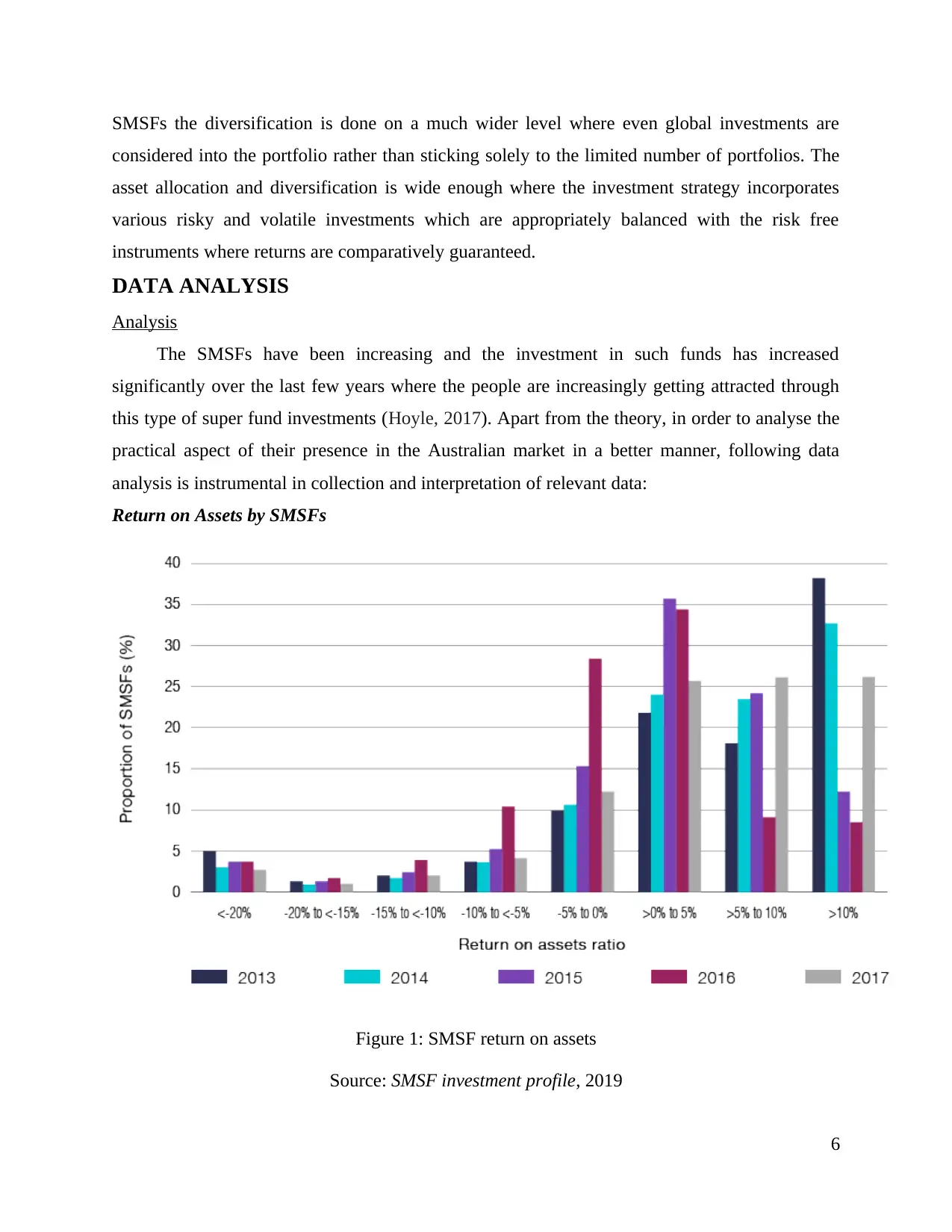
SMSFs the diversification is done on a much wider level where even global investments are
considered into the portfolio rather than sticking solely to the limited number of portfolios. The
asset allocation and diversification is wide enough where the investment strategy incorporates
various risky and volatile investments which are appropriately balanced with the risk free
instruments where returns are comparatively guaranteed.
DATA ANALYSIS
Analysis
The SMSFs have been increasing and the investment in such funds has increased
significantly over the last few years where the people are increasingly getting attracted through
this type of super fund investments (Hoyle, 2017). Apart from the theory, in order to analyse the
practical aspect of their presence in the Australian market in a better manner, following data
analysis is instrumental in collection and interpretation of relevant data:
Return on Assets by SMSFs
Figure 1: SMSF return on assets
Source: SMSF investment profile, 2019
6
considered into the portfolio rather than sticking solely to the limited number of portfolios. The
asset allocation and diversification is wide enough where the investment strategy incorporates
various risky and volatile investments which are appropriately balanced with the risk free
instruments where returns are comparatively guaranteed.
DATA ANALYSIS
Analysis
The SMSFs have been increasing and the investment in such funds has increased
significantly over the last few years where the people are increasingly getting attracted through
this type of super fund investments (Hoyle, 2017). Apart from the theory, in order to analyse the
practical aspect of their presence in the Australian market in a better manner, following data
analysis is instrumental in collection and interpretation of relevant data:
Return on Assets by SMSFs
Figure 1: SMSF return on assets
Source: SMSF investment profile, 2019
6
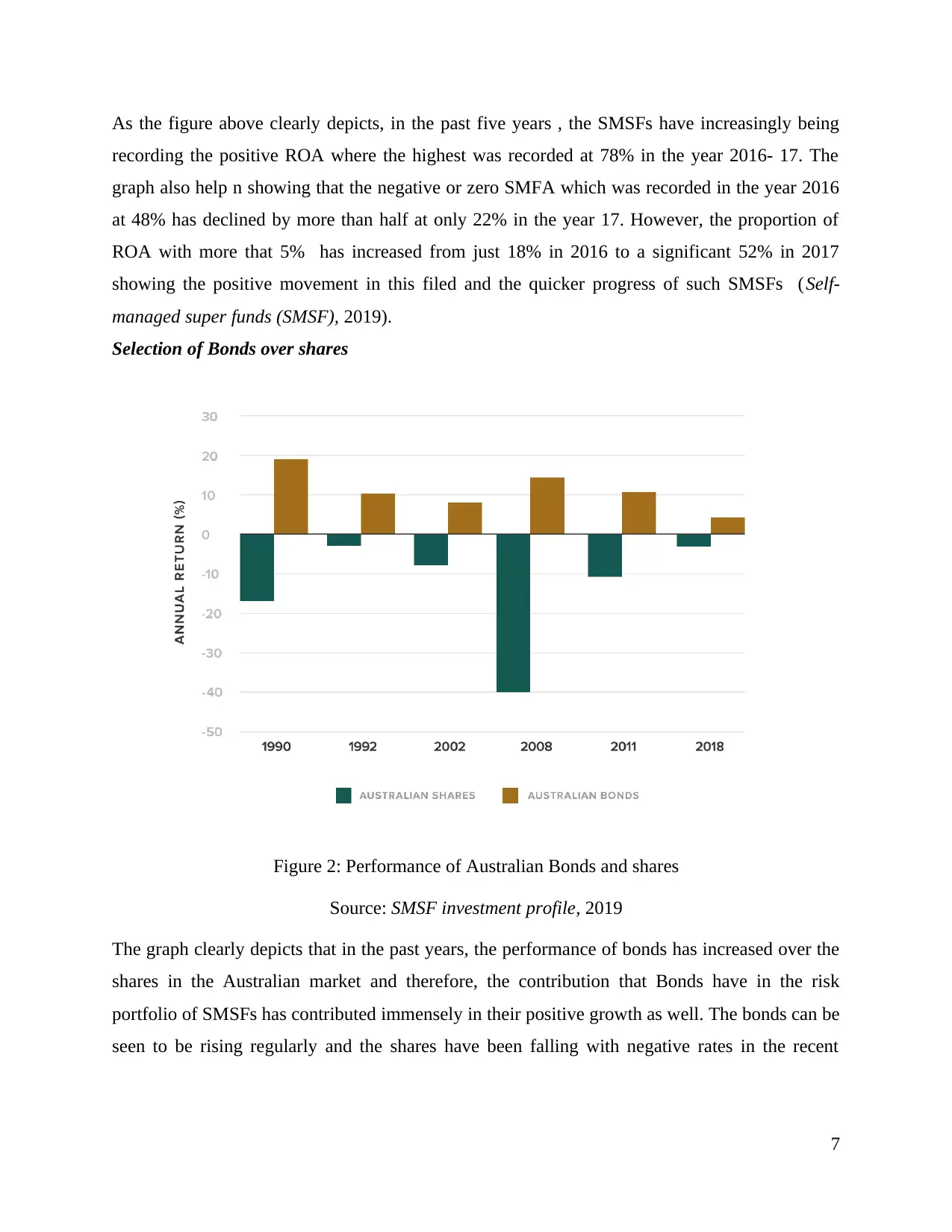
As the figure above clearly depicts, in the past five years , the SMSFs have increasingly being
recording the positive ROA where the highest was recorded at 78% in the year 2016- 17. The
graph also help n showing that the negative or zero SMFA which was recorded in the year 2016
at 48% has declined by more than half at only 22% in the year 17. However, the proportion of
ROA with more that 5% has increased from just 18% in 2016 to a significant 52% in 2017
showing the positive movement in this filed and the quicker progress of such SMSFs (Self-
managed super funds (SMSF), 2019).
Selection of Bonds over shares
Figure 2: Performance of Australian Bonds and shares
Source: SMSF investment profile, 2019
The graph clearly depicts that in the past years, the performance of bonds has increased over the
shares in the Australian market and therefore, the contribution that Bonds have in the risk
portfolio of SMSFs has contributed immensely in their positive growth as well. The bonds can be
seen to be rising regularly and the shares have been falling with negative rates in the recent
7
recording the positive ROA where the highest was recorded at 78% in the year 2016- 17. The
graph also help n showing that the negative or zero SMFA which was recorded in the year 2016
at 48% has declined by more than half at only 22% in the year 17. However, the proportion of
ROA with more that 5% has increased from just 18% in 2016 to a significant 52% in 2017
showing the positive movement in this filed and the quicker progress of such SMSFs (Self-
managed super funds (SMSF), 2019).
Selection of Bonds over shares
Figure 2: Performance of Australian Bonds and shares
Source: SMSF investment profile, 2019
The graph clearly depicts that in the past years, the performance of bonds has increased over the
shares in the Australian market and therefore, the contribution that Bonds have in the risk
portfolio of SMSFs has contributed immensely in their positive growth as well. The bonds can be
seen to be rising regularly and the shares have been falling with negative rates in the recent
7
Secure Best Marks with AI Grader
Need help grading? Try our AI Grader for instant feedback on your assignments.
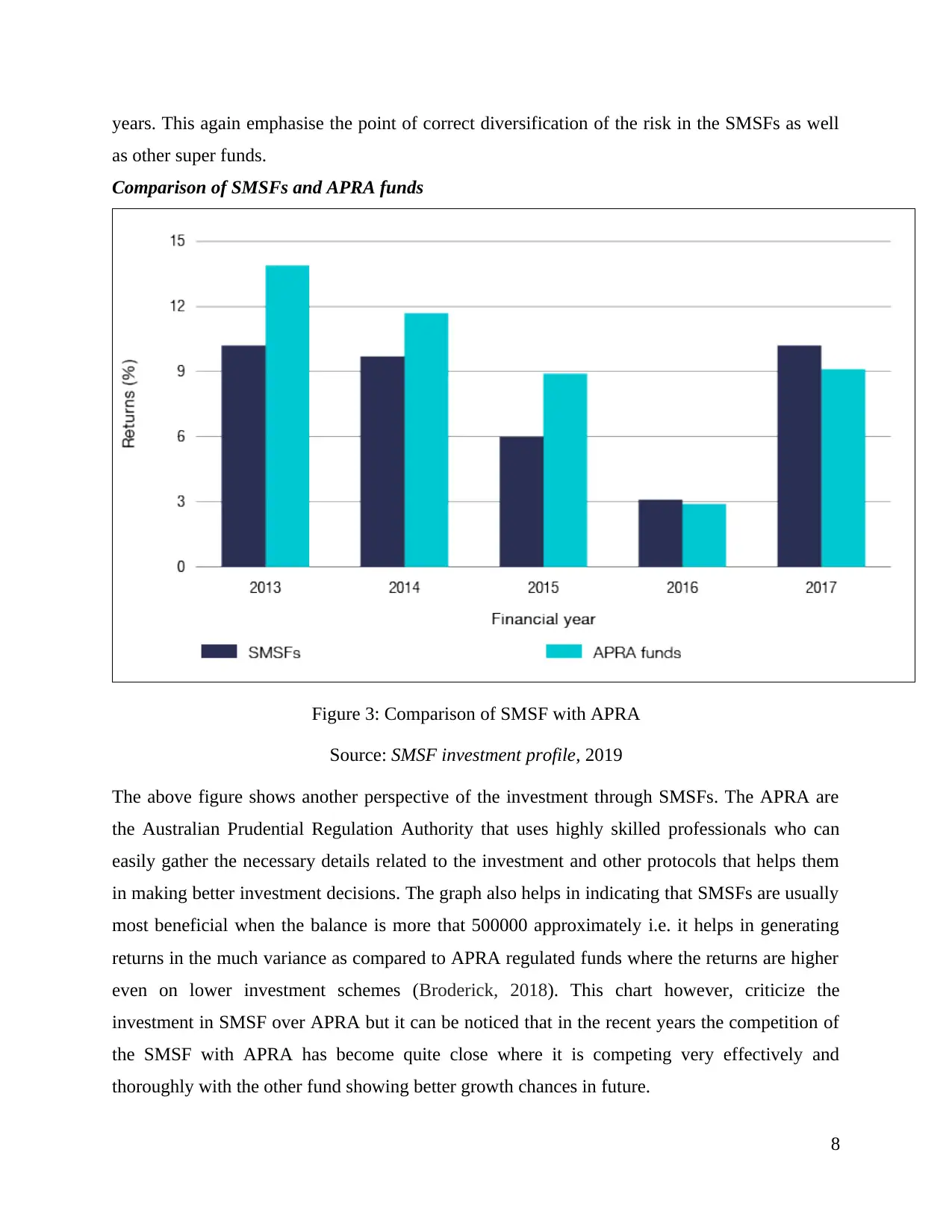
years. This again emphasise the point of correct diversification of the risk in the SMSFs as well
as other super funds.
Comparison of SMSFs and APRA funds
Figure 3: Comparison of SMSF with APRA
Source: SMSF investment profile, 2019
The above figure shows another perspective of the investment through SMSFs. The APRA are
the Australian Prudential Regulation Authority that uses highly skilled professionals who can
easily gather the necessary details related to the investment and other protocols that helps them
in making better investment decisions. The graph also helps in indicating that SMSFs are usually
most beneficial when the balance is more that 500000 approximately i.e. it helps in generating
returns in the much variance as compared to APRA regulated funds where the returns are higher
even on lower investment schemes (Broderick, 2018). This chart however, criticize the
investment in SMSF over APRA but it can be noticed that in the recent years the competition of
the SMSF with APRA has become quite close where it is competing very effectively and
thoroughly with the other fund showing better growth chances in future.
8
as other super funds.
Comparison of SMSFs and APRA funds
Figure 3: Comparison of SMSF with APRA
Source: SMSF investment profile, 2019
The above figure shows another perspective of the investment through SMSFs. The APRA are
the Australian Prudential Regulation Authority that uses highly skilled professionals who can
easily gather the necessary details related to the investment and other protocols that helps them
in making better investment decisions. The graph also helps in indicating that SMSFs are usually
most beneficial when the balance is more that 500000 approximately i.e. it helps in generating
returns in the much variance as compared to APRA regulated funds where the returns are higher
even on lower investment schemes (Broderick, 2018). This chart however, criticize the
investment in SMSF over APRA but it can be noticed that in the recent years the competition of
the SMSF with APRA has become quite close where it is competing very effectively and
thoroughly with the other fund showing better growth chances in future.
8

Return on the basis of fund size
Figure 4: SMSF returns on the assets by funds size for year 2017
Source: SMSF investment profile, 2019
The graph above is another illustration of the returns that SMSFs have given over the investment
that have been made on the basis of size of funds respectively. It was analysed and identified on
the basis of the graph that the average ROA on the basis of SMSF size i.e. when the funds are
above the $200000, then the assets were found to have positive ROA in the year 2017. The
reason behind this is directly linked with the risks taking of e= fund managers on the basis of
investments that are being made. The fund with more investment will have better returns as well
as compared to others.
SMSF members by age
9
Figure 4: SMSF returns on the assets by funds size for year 2017
Source: SMSF investment profile, 2019
The graph above is another illustration of the returns that SMSFs have given over the investment
that have been made on the basis of size of funds respectively. It was analysed and identified on
the basis of the graph that the average ROA on the basis of SMSF size i.e. when the funds are
above the $200000, then the assets were found to have positive ROA in the year 2017. The
reason behind this is directly linked with the risks taking of e= fund managers on the basis of
investments that are being made. The fund with more investment will have better returns as well
as compared to others.
SMSF members by age
9
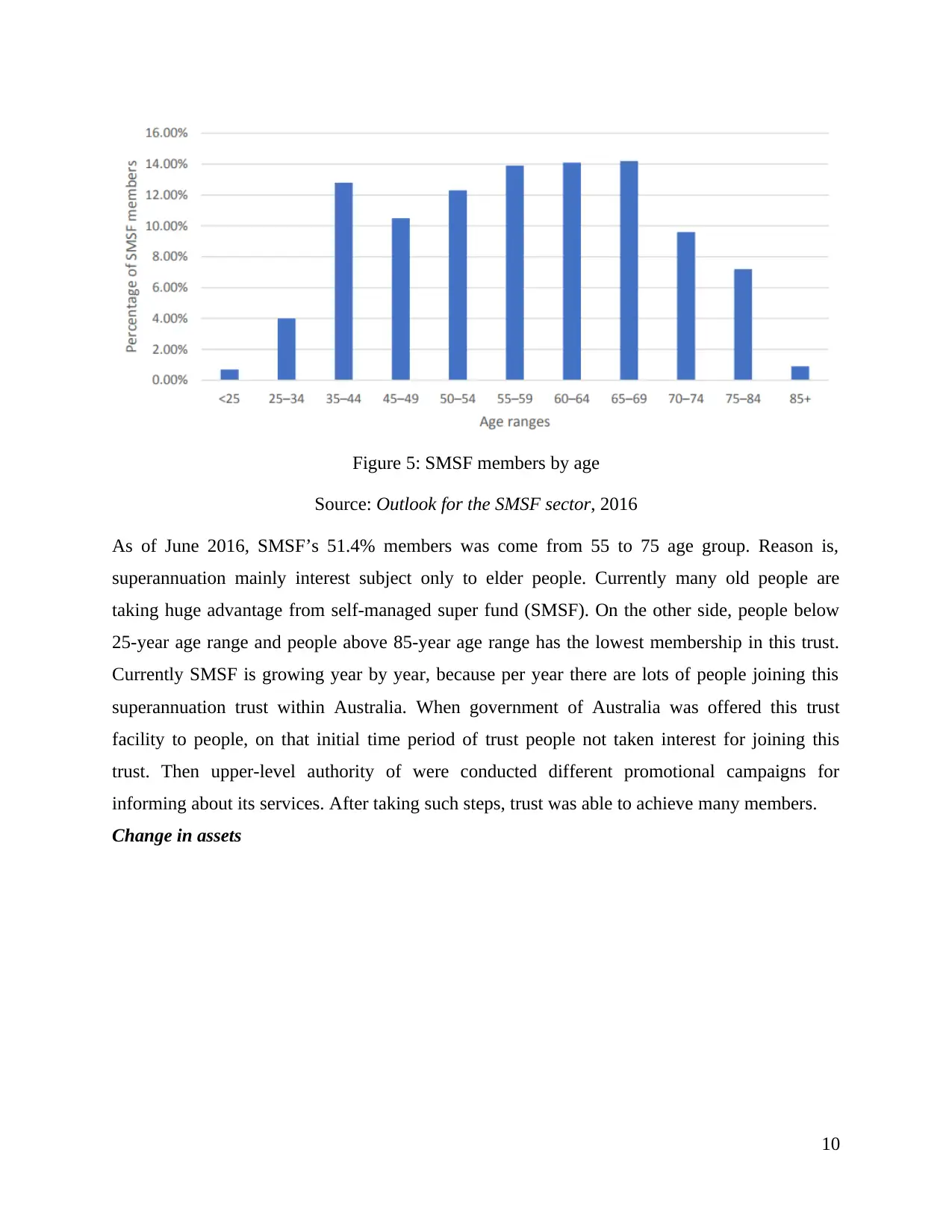
Figure 5: SMSF members by age
Source: Outlook for the SMSF sector, 2016
As of June 2016, SMSF’s 51.4% members was come from 55 to 75 age group. Reason is,
superannuation mainly interest subject only to elder people. Currently many old people are
taking huge advantage from self-managed super fund (SMSF). On the other side, people below
25-year age range and people above 85-year age range has the lowest membership in this trust.
Currently SMSF is growing year by year, because per year there are lots of people joining this
superannuation trust within Australia. When government of Australia was offered this trust
facility to people, on that initial time period of trust people not taken interest for joining this
trust. Then upper-level authority of were conducted different promotional campaigns for
informing about its services. After taking such steps, trust was able to achieve many members.
Change in assets
10
Source: Outlook for the SMSF sector, 2016
As of June 2016, SMSF’s 51.4% members was come from 55 to 75 age group. Reason is,
superannuation mainly interest subject only to elder people. Currently many old people are
taking huge advantage from self-managed super fund (SMSF). On the other side, people below
25-year age range and people above 85-year age range has the lowest membership in this trust.
Currently SMSF is growing year by year, because per year there are lots of people joining this
superannuation trust within Australia. When government of Australia was offered this trust
facility to people, on that initial time period of trust people not taken interest for joining this
trust. Then upper-level authority of were conducted different promotional campaigns for
informing about its services. After taking such steps, trust was able to achieve many members.
Change in assets
10
Paraphrase This Document
Need a fresh take? Get an instant paraphrase of this document with our AI Paraphraser
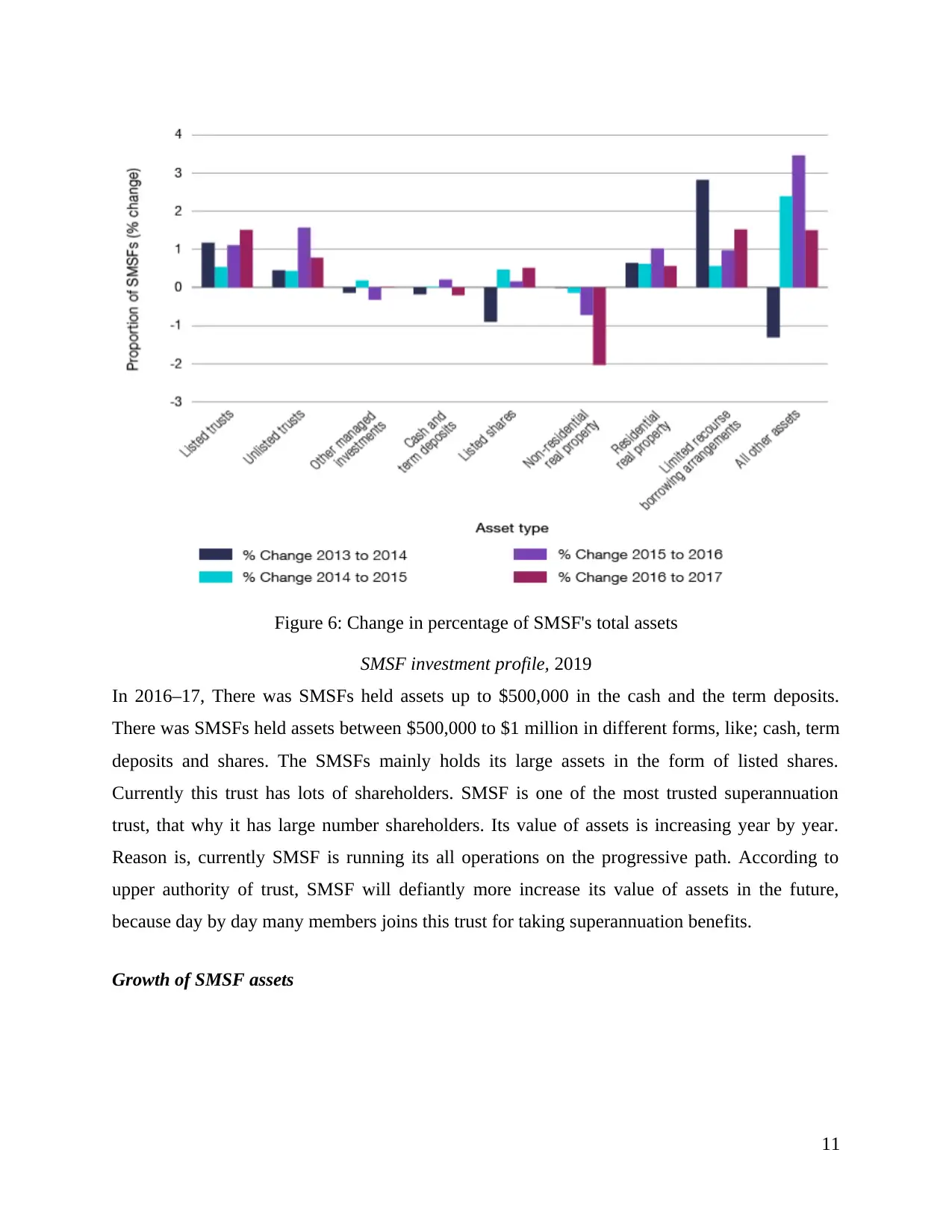
Figure 6: Change in percentage of SMSF's total assets
SMSF investment profile, 2019
In 2016–17, There was SMSFs held assets up to $500,000 in the cash and the term deposits.
There was SMSFs held assets between $500,000 to $1 million in different forms, like; cash, term
deposits and shares. The SMSFs mainly holds its large assets in the form of listed shares.
Currently this trust has lots of shareholders. SMSF is one of the most trusted superannuation
trust, that why it has large number shareholders. Its value of assets is increasing year by year.
Reason is, currently SMSF is running its all operations on the progressive path. According to
upper authority of trust, SMSF will defiantly more increase its value of assets in the future,
because day by day many members joins this trust for taking superannuation benefits.
Growth of SMSF assets
11
SMSF investment profile, 2019
In 2016–17, There was SMSFs held assets up to $500,000 in the cash and the term deposits.
There was SMSFs held assets between $500,000 to $1 million in different forms, like; cash, term
deposits and shares. The SMSFs mainly holds its large assets in the form of listed shares.
Currently this trust has lots of shareholders. SMSF is one of the most trusted superannuation
trust, that why it has large number shareholders. Its value of assets is increasing year by year.
Reason is, currently SMSF is running its all operations on the progressive path. According to
upper authority of trust, SMSF will defiantly more increase its value of assets in the future,
because day by day many members joins this trust for taking superannuation benefits.
Growth of SMSF assets
11
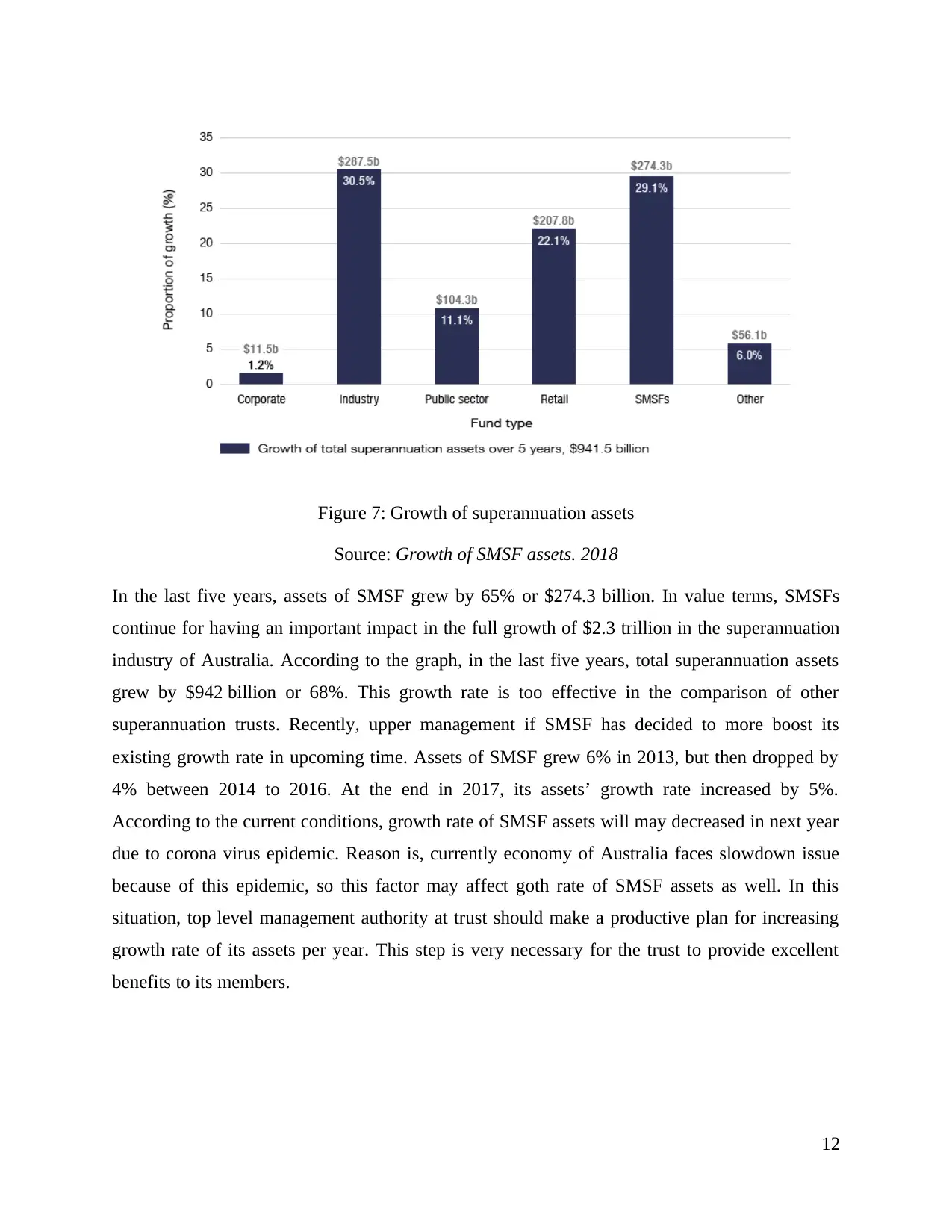
Figure 7: Growth of superannuation assets
Source: Growth of SMSF assets. 2018
In the last five years, assets of SMSF grew by 65% or $274.3 billion. In value terms, SMSFs
continue for having an important impact in the full growth of $2.3 trillion in the superannuation
industry of Australia. According to the graph, in the last five years, total superannuation assets
grew by $942 billion or 68%. This growth rate is too effective in the comparison of other
superannuation trusts. Recently, upper management if SMSF has decided to more boost its
existing growth rate in upcoming time. Assets of SMSF grew 6% in 2013, but then dropped by
4% between 2014 to 2016. At the end in 2017, its assets’ growth rate increased by 5%.
According to the current conditions, growth rate of SMSF assets will may decreased in next year
due to corona virus epidemic. Reason is, currently economy of Australia faces slowdown issue
because of this epidemic, so this factor may affect goth rate of SMSF assets as well. In this
situation, top level management authority at trust should make a productive plan for increasing
growth rate of its assets per year. This step is very necessary for the trust to provide excellent
benefits to its members.
12
Source: Growth of SMSF assets. 2018
In the last five years, assets of SMSF grew by 65% or $274.3 billion. In value terms, SMSFs
continue for having an important impact in the full growth of $2.3 trillion in the superannuation
industry of Australia. According to the graph, in the last five years, total superannuation assets
grew by $942 billion or 68%. This growth rate is too effective in the comparison of other
superannuation trusts. Recently, upper management if SMSF has decided to more boost its
existing growth rate in upcoming time. Assets of SMSF grew 6% in 2013, but then dropped by
4% between 2014 to 2016. At the end in 2017, its assets’ growth rate increased by 5%.
According to the current conditions, growth rate of SMSF assets will may decreased in next year
due to corona virus epidemic. Reason is, currently economy of Australia faces slowdown issue
because of this epidemic, so this factor may affect goth rate of SMSF assets as well. In this
situation, top level management authority at trust should make a productive plan for increasing
growth rate of its assets per year. This step is very necessary for the trust to provide excellent
benefits to its members.
12
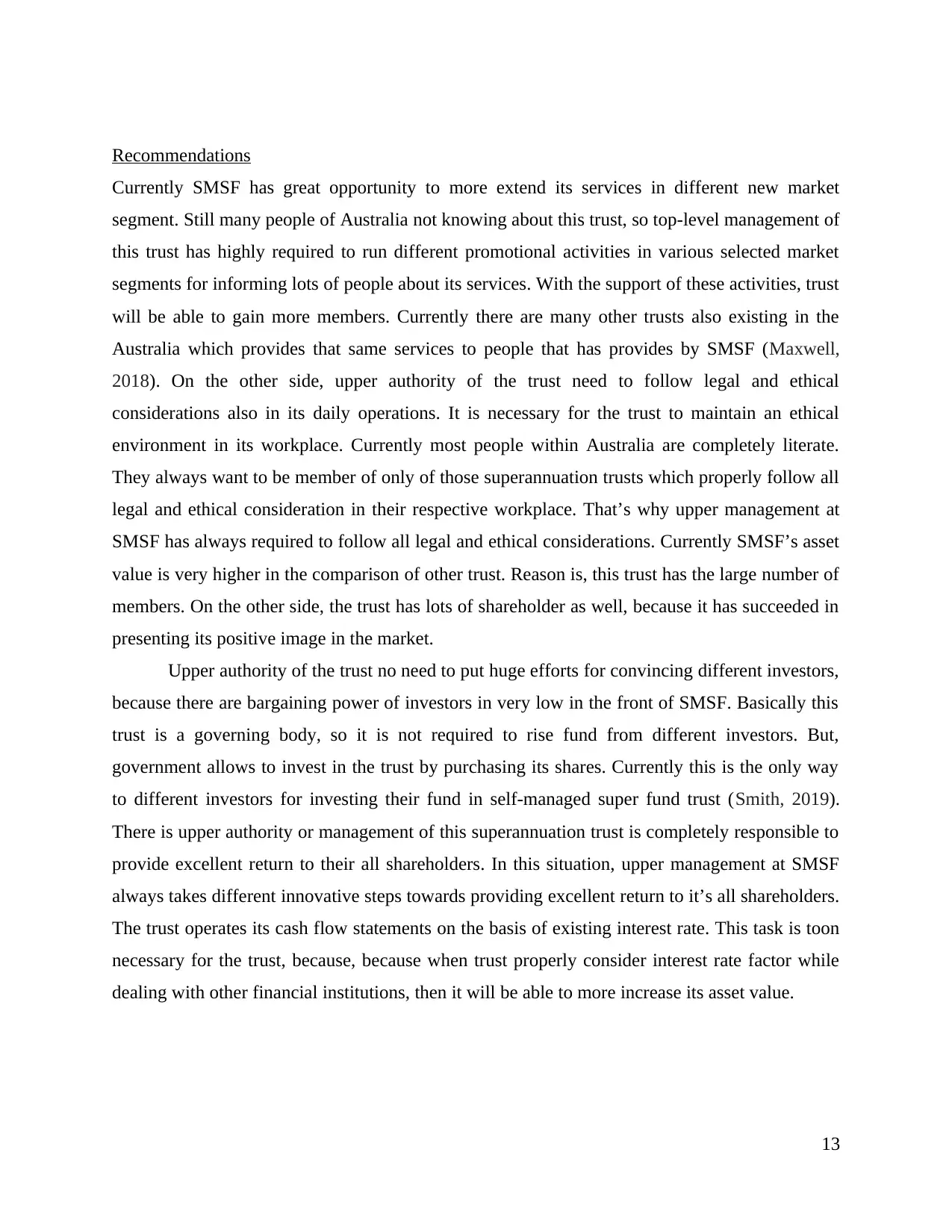
Recommendations
Currently SMSF has great opportunity to more extend its services in different new market
segment. Still many people of Australia not knowing about this trust, so top-level management of
this trust has highly required to run different promotional activities in various selected market
segments for informing lots of people about its services. With the support of these activities, trust
will be able to gain more members. Currently there are many other trusts also existing in the
Australia which provides that same services to people that has provides by SMSF (Maxwell,
2018). On the other side, upper authority of the trust need to follow legal and ethical
considerations also in its daily operations. It is necessary for the trust to maintain an ethical
environment in its workplace. Currently most people within Australia are completely literate.
They always want to be member of only of those superannuation trusts which properly follow all
legal and ethical consideration in their respective workplace. That’s why upper management at
SMSF has always required to follow all legal and ethical considerations. Currently SMSF’s asset
value is very higher in the comparison of other trust. Reason is, this trust has the large number of
members. On the other side, the trust has lots of shareholder as well, because it has succeeded in
presenting its positive image in the market.
Upper authority of the trust no need to put huge efforts for convincing different investors,
because there are bargaining power of investors in very low in the front of SMSF. Basically this
trust is a governing body, so it is not required to rise fund from different investors. But,
government allows to invest in the trust by purchasing its shares. Currently this is the only way
to different investors for investing their fund in self-managed super fund trust (Smith, 2019).
There is upper authority or management of this superannuation trust is completely responsible to
provide excellent return to their all shareholders. In this situation, upper management at SMSF
always takes different innovative steps towards providing excellent return to it’s all shareholders.
The trust operates its cash flow statements on the basis of existing interest rate. This task is toon
necessary for the trust, because, because when trust properly consider interest rate factor while
dealing with other financial institutions, then it will be able to more increase its asset value.
13
Currently SMSF has great opportunity to more extend its services in different new market
segment. Still many people of Australia not knowing about this trust, so top-level management of
this trust has highly required to run different promotional activities in various selected market
segments for informing lots of people about its services. With the support of these activities, trust
will be able to gain more members. Currently there are many other trusts also existing in the
Australia which provides that same services to people that has provides by SMSF (Maxwell,
2018). On the other side, upper authority of the trust need to follow legal and ethical
considerations also in its daily operations. It is necessary for the trust to maintain an ethical
environment in its workplace. Currently most people within Australia are completely literate.
They always want to be member of only of those superannuation trusts which properly follow all
legal and ethical consideration in their respective workplace. That’s why upper management at
SMSF has always required to follow all legal and ethical considerations. Currently SMSF’s asset
value is very higher in the comparison of other trust. Reason is, this trust has the large number of
members. On the other side, the trust has lots of shareholder as well, because it has succeeded in
presenting its positive image in the market.
Upper authority of the trust no need to put huge efforts for convincing different investors,
because there are bargaining power of investors in very low in the front of SMSF. Basically this
trust is a governing body, so it is not required to rise fund from different investors. But,
government allows to invest in the trust by purchasing its shares. Currently this is the only way
to different investors for investing their fund in self-managed super fund trust (Smith, 2019).
There is upper authority or management of this superannuation trust is completely responsible to
provide excellent return to their all shareholders. In this situation, upper management at SMSF
always takes different innovative steps towards providing excellent return to it’s all shareholders.
The trust operates its cash flow statements on the basis of existing interest rate. This task is toon
necessary for the trust, because, because when trust properly consider interest rate factor while
dealing with other financial institutions, then it will be able to more increase its asset value.
13
Secure Best Marks with AI Grader
Need help grading? Try our AI Grader for instant feedback on your assignments.
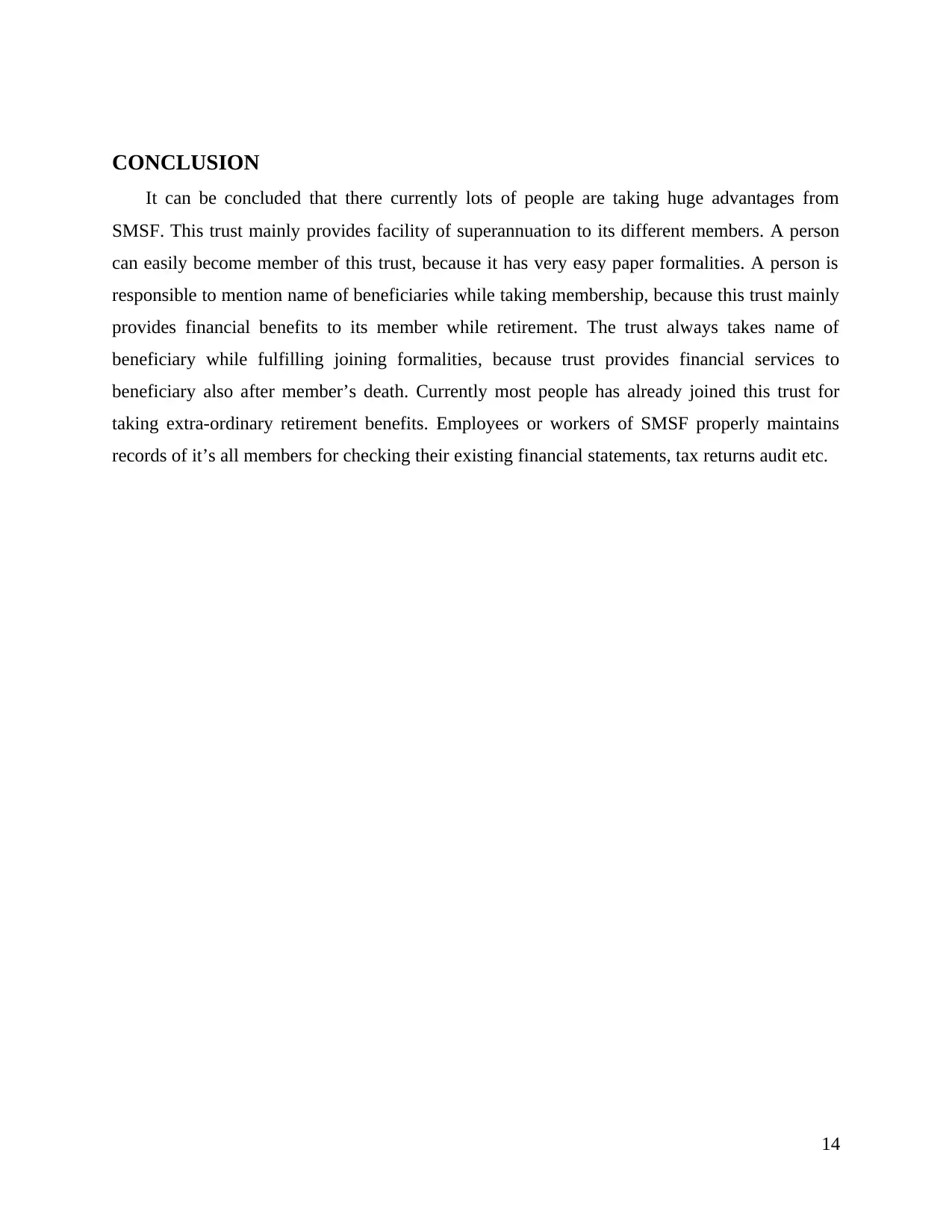
CONCLUSION
It can be concluded that there currently lots of people are taking huge advantages from
SMSF. This trust mainly provides facility of superannuation to its different members. A person
can easily become member of this trust, because it has very easy paper formalities. A person is
responsible to mention name of beneficiaries while taking membership, because this trust mainly
provides financial benefits to its member while retirement. The trust always takes name of
beneficiary while fulfilling joining formalities, because trust provides financial services to
beneficiary also after member’s death. Currently most people has already joined this trust for
taking extra-ordinary retirement benefits. Employees or workers of SMSF properly maintains
records of it’s all members for checking their existing financial statements, tax returns audit etc.
14
It can be concluded that there currently lots of people are taking huge advantages from
SMSF. This trust mainly provides facility of superannuation to its different members. A person
can easily become member of this trust, because it has very easy paper formalities. A person is
responsible to mention name of beneficiaries while taking membership, because this trust mainly
provides financial benefits to its member while retirement. The trust always takes name of
beneficiary while fulfilling joining formalities, because trust provides financial services to
beneficiary also after member’s death. Currently most people has already joined this trust for
taking extra-ordinary retirement benefits. Employees or workers of SMSF properly maintains
records of it’s all members for checking their existing financial statements, tax returns audit etc.
14
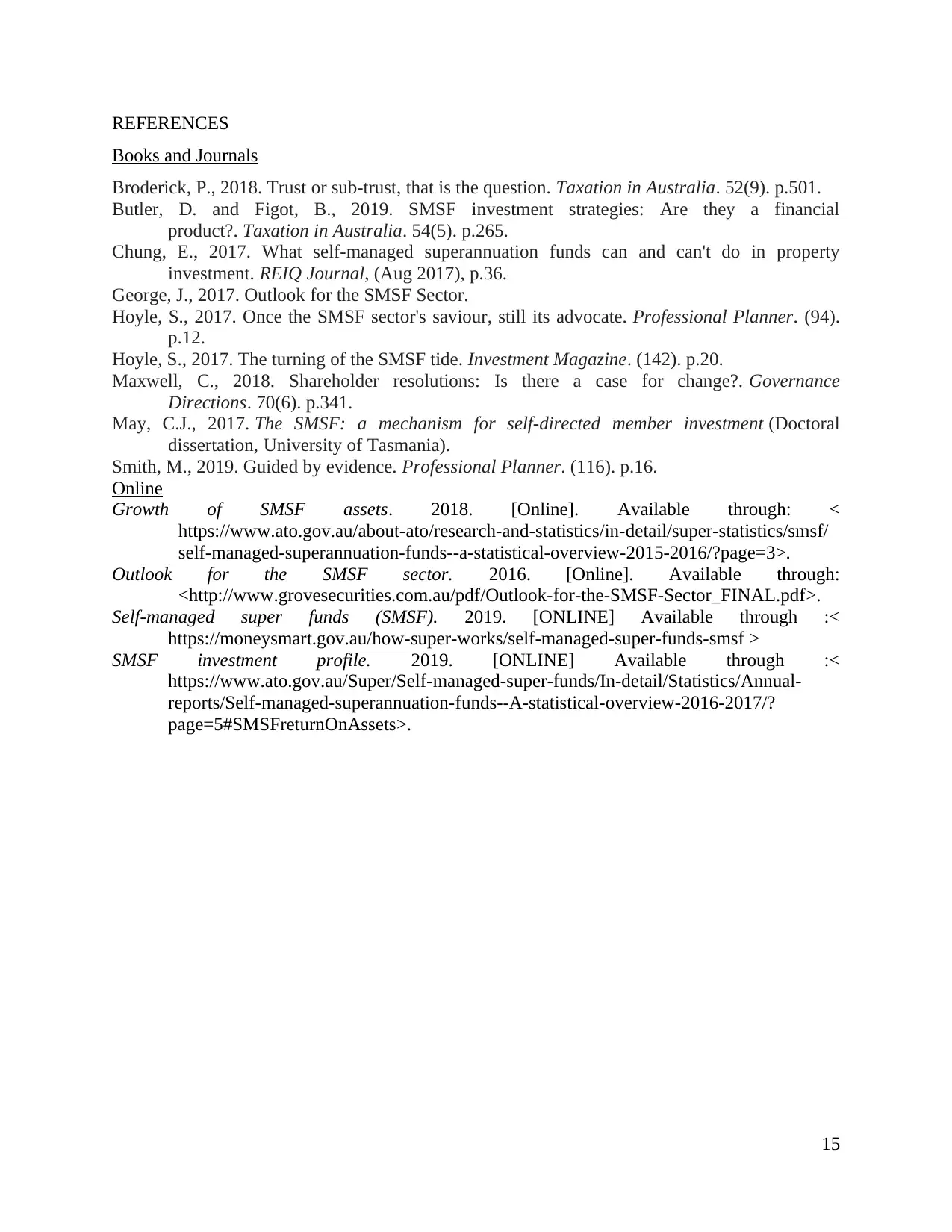
REFERENCES
Books and Journals
Broderick, P., 2018. Trust or sub-trust, that is the question. Taxation in Australia. 52(9). p.501.
Butler, D. and Figot, B., 2019. SMSF investment strategies: Are they a financial
product?. Taxation in Australia. 54(5). p.265.
Chung, E., 2017. What self-managed superannuation funds can and can't do in property
investment. REIQ Journal, (Aug 2017), p.36.
George, J., 2017. Outlook for the SMSF Sector.
Hoyle, S., 2017. Once the SMSF sector's saviour, still its advocate. Professional Planner. (94).
p.12.
Hoyle, S., 2017. The turning of the SMSF tide. Investment Magazine. (142). p.20.
Maxwell, C., 2018. Shareholder resolutions: Is there a case for change?. Governance
Directions. 70(6). p.341.
May, C.J., 2017. The SMSF: a mechanism for self-directed member investment (Doctoral
dissertation, University of Tasmania).
Smith, M., 2019. Guided by evidence. Professional Planner. (116). p.16.
Online
Growth of SMSF assets. 2018. [Online]. Available through: <
https://www.ato.gov.au/about-ato/research-and-statistics/in-detail/super-statistics/smsf/
self-managed-superannuation-funds--a-statistical-overview-2015-2016/?page=3>.
Outlook for the SMSF sector. 2016. [Online]. Available through:
<http://www.grovesecurities.com.au/pdf/Outlook-for-the-SMSF-Sector_FINAL.pdf>.
Self-managed super funds (SMSF). 2019. [ONLINE] Available through :<
https://moneysmart.gov.au/how-super-works/self-managed-super-funds-smsf >
SMSF investment profile. 2019. [ONLINE] Available through :<
https://www.ato.gov.au/Super/Self-managed-super-funds/In-detail/Statistics/Annual-
reports/Self-managed-superannuation-funds--A-statistical-overview-2016-2017/?
page=5#SMSFreturnOnAssets>.
15
Books and Journals
Broderick, P., 2018. Trust or sub-trust, that is the question. Taxation in Australia. 52(9). p.501.
Butler, D. and Figot, B., 2019. SMSF investment strategies: Are they a financial
product?. Taxation in Australia. 54(5). p.265.
Chung, E., 2017. What self-managed superannuation funds can and can't do in property
investment. REIQ Journal, (Aug 2017), p.36.
George, J., 2017. Outlook for the SMSF Sector.
Hoyle, S., 2017. Once the SMSF sector's saviour, still its advocate. Professional Planner. (94).
p.12.
Hoyle, S., 2017. The turning of the SMSF tide. Investment Magazine. (142). p.20.
Maxwell, C., 2018. Shareholder resolutions: Is there a case for change?. Governance
Directions. 70(6). p.341.
May, C.J., 2017. The SMSF: a mechanism for self-directed member investment (Doctoral
dissertation, University of Tasmania).
Smith, M., 2019. Guided by evidence. Professional Planner. (116). p.16.
Online
Growth of SMSF assets. 2018. [Online]. Available through: <
https://www.ato.gov.au/about-ato/research-and-statistics/in-detail/super-statistics/smsf/
self-managed-superannuation-funds--a-statistical-overview-2015-2016/?page=3>.
Outlook for the SMSF sector. 2016. [Online]. Available through:
<http://www.grovesecurities.com.au/pdf/Outlook-for-the-SMSF-Sector_FINAL.pdf>.
Self-managed super funds (SMSF). 2019. [ONLINE] Available through :<
https://moneysmart.gov.au/how-super-works/self-managed-super-funds-smsf >
SMSF investment profile. 2019. [ONLINE] Available through :<
https://www.ato.gov.au/Super/Self-managed-super-funds/In-detail/Statistics/Annual-
reports/Self-managed-superannuation-funds--A-statistical-overview-2016-2017/?
page=5#SMSFreturnOnAssets>.
15

16
1 out of 16
Related Documents
Your All-in-One AI-Powered Toolkit for Academic Success.
+13062052269
info@desklib.com
Available 24*7 on WhatsApp / Email
![[object Object]](/_next/static/media/star-bottom.7253800d.svg)
Unlock your academic potential
© 2024 | Zucol Services PVT LTD | All rights reserved.





